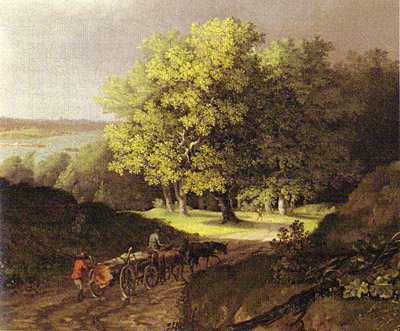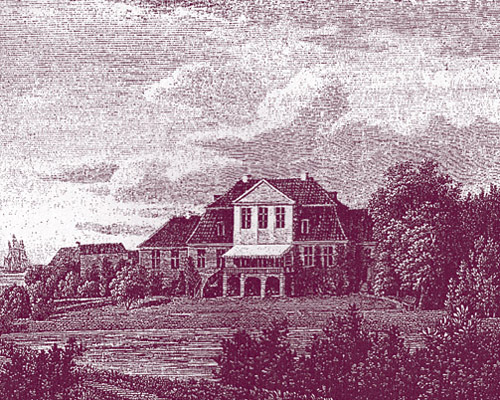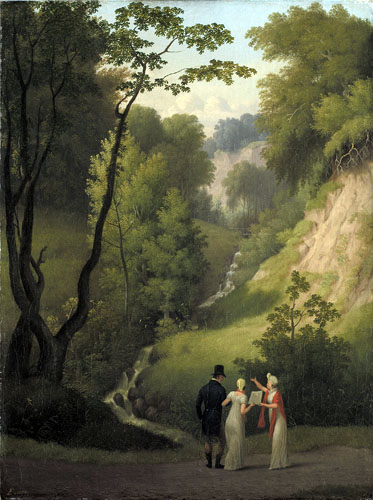| Romantik

| | Den tidlige romantik tager afsæt i naturfølsom og patriotisme. En fædrelandskærlighed der dog ikke skelner imellem dansk,tysk, eller norsk indenfor den enevældige helstat.
Henimod slutningen af 1700-tallet udvikler Hellebæk på Sjællands nordkyst sig til en centrum for en ny tids åndelige strømninger. |
Romantik og patriotisme

| | Den tidlige romantik i slutningen af 1700-tallet tager udgangspunkt i naturfølsomhed og patriotisme.
Geværfabrikanten Ernst Schimmelmann samlede en kreds af tidens åndspersoner omkring sig, bl.a. ved sammenkomster og besøg på Hellebækgård i Nordsjælland om sommeren. |
Henimod slutningen af 1700-tallet udvikledes Hellebæk sig til et centrum for en ny tids åndelige strømninger, romantikken. Den tidlige romantik tog udgangspunkt i naturfølsomhed og patriotisme, en fædrelandskærlighed der dog ikke skelnede imellem dansk, tysk eller norsk indenfor den enevældige, danske helstats grænser.
Hyldest til Hellebæk
Naturen omkring Hellebæk appellerede åbenlyst til den tidlige romantiske ånd i anden halvdel af 1700-tallet og den unge Ernst Schimmelmann, som omkring 1768 overtog ledelsen af geværfabrikken i Hellebæk på sin faders vegne, var levende interesseret i tidens naturfølsomme tankegang. Efter det første besøg på lokaliteten beskriver han i et brev til sin ven juristen August Hennings omgivelserne således:
"Jeg kommer i dag tilbage fra Helsingøer hvor jeg har tilbragt to Dage for at besee Geværfabriken, som ligger en halv Mils Vej paa den anden Side af denne By.
De kan ikke tænke Dem noget mere henrivende Sted. De forskjelligste, de meest romantiske Naturscener ere der forenede. Det ligger ved Bredden af Havet. der uophørligt er bedækket med Skibe; lige overfor ser man Sverigs Klipper. Søger De en ensom eller rolig Plet, behøver De blot at gaa ind i Skoven. som gjemmer en Rigdom af Søer; er De træt af disse, ville forskjeliige Bække oplive Dem med deres Rislen. Høie med bliide Skraaninger, dunkle og stille Dale - dog, min Kjære, jeg veed ikke, hvorledes jeg bærer mig ad; men jeg beskriver meget kummerligt det skiønneste Sted i Verden. See bort fra min Beskrivelse, og forestil Dem et fuldkomment henrivende Landskab: fortryllende om Sommeren og højtidsfuldt om Vinteren.
Alt dette er kun en Forberedelse; men mit projektrige Hoved har undfanget en Ide, nemlig den, at vi - hvis De kommer Elskværdigste - meget godt kunne sige Verden farvel for en Maaned eller længere og kaste os i Armene paa denne tiltrækkende Ensomhed…"
Friedrich Leopold, greve af Stolberg, skrev i 1776 et digt til "Hellebeck. Eine Seeländische Gegend". Friedrich Stolbergs far var overhofmester hos enkedronning Sofie Amalie på Hørsholm gods, hvor han medvirkede til at iværksætte de tidligste landboreformer omkring 1750.
Sønnen Friedrich studerede i Göttingen, hvor han kom i nærmere berøring med Klopstocks romantik. Sine tidlige år tilbragte han imidlertid i Danmark og det er Øresund han besynger i sine hymner til havet. Naturen er i centrum for hans lyrik, den betragtes som hellig og mennesket er i pagt med naturen. Det er universalromantik i tidlig klædning.

Ernst Schimmelmann 1747-1831 |
Samlingspunkt
Ernst Schimmelmann samlede en kreds af tidens åndspersoner omkring sig, bl.a. ved sammenkomster og besøg på Hellebækgård om sommeren. Blandt gæsterne var de romantiske digtere Friedrich Klopstock, Friedrich Stolberg, Jens Baggesen og Adam Oehlenschläger, filosoffen Heinrich Steffens og naturvidenskabsmanden H.C.Ørsted.
I denne tidlige fase af romantikken, førend nationalromantik og nationalfølelse for alvor sætter sig igennem, skelnede man indenfor helstaten ikke imellem tysk og dansk, eller for den sags skyld norsk, og betegnende herfor udkommer Jens Baggesens ode til Ernst Schimmelmann med titlen "Hellebecks Harpe" i tysk redaktion i 1801.

Jens Baggesen 1764 - 1826 | 
A. Oehlenschläger 1779-1850 | 
H.C. Ørsted 1777-1851 |
Folk og Fædreland
Romantikkens gennembrud i Danmark regnes ofte med Adam Oehlensclägers Digte 1803, som han skriver under påvirkning af filosoffen Heinrich Steffens, født i Norge, opvokset i Danmark og uddannet i Tyskland. Oehlenschläger blev skarp forfulgt af dansk-tyskeren Schack Staffelt født på Rügen, der udsendte Digte 1804, men allerede i 1793 havde leveret en romantisk hilsen til Øresund
Den intense naturdyrkelse er et karakteristisk træk ved den tidlige romantik, patriotismen et andet. Patriotisme betyder fædrelandskærlighed, men i første omgang ikke i nationalromantikkens snævre forstand, hvor en nation forbindes med begrebet folk i betydningen en gruppe mennesker, som har samme sprog, kultur og historie. Denne opfattelse tager form i tiden omkring den franske revolution, men endnu er mange af Europas lande, ligesom Danmark-Norge, multinationale samfund, der statsligt er knyttet sammen af en fælles fyrstemagt.
Ikke desto mindre var den nationale fællesskabsfølelse i anmarch og man begyndte også at få øje på folket. Dette havde også rod i oplysningstidens interesse for særegne befolkningsgrupper og deres levevis og gerninger. Denne interesse viser sig allerede i forbindelse med kong Christian d.6.s rejse til Norge i 1733 og siden hen med etableringen af Normandsdalen i Fredensborg Slotspark, hvor der blev opstillet en lang række statuer af mere eksotiske repræsentanter for kongeriget.

Heinrich Steffens |
Johannes Ewald
I den danske helstat havde man indtil videre hovedsagelig blik for heroiske og opofrende gerninger i fortid og nutid som kunne styrke og gavne samfundet og fællesskabsfølelsen. Et godt eksempel på en sådan begivenhed er en stranding på Nordsjælland kyst, nærmere betegnet Hornbæk, hvor lokale fiskere d. 9.11.1774 på heltemodig vis kastede sig ud i en redningsaktion.
Poeten Johannes Ewald bliver opfordret til at skildre begivenheden og skriver syngespillet "Fiskerne" som opføres i 1779. Herfra stammer nationalsangen, den såkaldte kongesang, "Kong Kristian". Tidligere konger og søheltes store patriotiske gerninger besynges og forbindes i skuespillet med den jævne mands opofrende og heltemodige optræden og hermed knyttes båndene imellem folk og regent.
Allerede i 1776 havde Ewald haft stor succes med en Ode til Indfødsretten. Loven om Indfødsretten bestemte at embeder i administrationen var forbeholdt personer der var født i helstaten. Dette skulle med andre ord styrke helstatspatriotismen og kom som en reaktion på den massive tyske indflydelse i Struenses regeringstid (1770-73). Johannes Ewald var i øvrigt var tæt knyttet til det nordsjællandske, han besang Rungsteds Lyksaligheder og hans Ode til Sjælen er forfattet i hans tid i Espergærde-Humlebæk.

Johannes Ewald 1743-1781 | 
Kongesangen |
Den romantiske Have

| | I slutningen af 1700-tallet blev en række af de kongelige haver omlagt fra barok stilen til den romantiske stil. Det drejede sig bl.a. om Frederiksberg have og Marienlyst slotshave ved Helsingør
Aristokratiet lod sig også inspirere af den nye havestil. Liselund på Møn er et godt eksempel på dette. |
En ny havetype
Så sent som i 1760erne anlagdes eller omlagdes både Fredensborg, Frederiksberg og Marienlyst haver til barokke haveanlæg i fransk stil med ustrakt orden og symmetri. Blot 30 år senere havde stilen skiftet til en mere landskabelig og oplevelsespræget have. Mens barokkens orden spejlede den kontinentale enevældes tid, så er den engelske, landskabelige have et varsel om nye tider.
Som den eneste af kongehusets slotshaver undgik barokhaven ved Frederiksborg Slot dog at blive omlagt til romantisk landskabshave. Det har formentlig været for vanskeligt og forbundet med store omkostninger at fælde de mange lindealléer og ændre det karakteristiske terrasseformede terræn.
I England fik man tidligt parlamentarisk styre med vægt på den enkeltes rettigheder og selvbestemmelse. Man skal selv kunne orientere sig i landskabet, også det politiske, og der åbnes op for en større, om man vil romantisk, følsomhed, som også er et varsel om en kommende tids borgerstyre.
Frederiksberg Have
En sammenligning af J.C. Kriegers tegning af Frederiksberg Have fra 1760 med Peter Petersens planskitse fra 1795 til en romantisk have samme sted åbenbarer med tydelighed forskellene imellem den barokke og den romantiske have. Mens barokhaven er præget af symmetri og regelmæssighed er det modsatte tilfældet med den romantiske planskitse: De centrale dele af haven er omdannet til et virvar af slyngede stier og vandsystemet er omskabt til et tilfældigt udseende bugtet forløb med tre søer.
Helt tilfældigt er det nu ikke. Alt er iscenesat, men det skal gerne ligne ”den rigtige” natur og den diffuse tilrettelæggelse lægger op til at den besøgende går på opdagelse i haven. Derfor er der også indlagt forskellige overraskelser: Et vandfald, et antikt tempel og den ene ø huser et kinesisk hus og en ditto gangbro. Disse momenter skal som sagt stimulere oplevelsen og stemme sindet følsomt. Frederiksberg Have er de senere år rekonstrueret som romantisk have, bl.a. er vandfaldet, som oprindelig var hestetrukket, genskabt.

Frederiksberg Have | 
Den romantiske have | 
Kongen i Frederiksberg Have. | 
Kinahuset | 
Kineserbroen |

Landskabshaven | 
Vandfaldet i Frederiksborg park |
Marienlysts romantiske have
Marienlyst ved Helsingør var i perioden 1759-64 blevet omskabt til et klassicistisk palæ og i 1667 forsynet med en barokhave i fransk stil. Officielt stod hofmarskal, greve A.G. Moltke som bygherre, men reelt var det kongen, Frederik 5.., der ejede foretagendet. Hans efterfølger Christian 7. benyttede slottet ved nogle enkelte officielle lejligheder, men det overgik snart til hans stedmoder enkedronning Juliane Marie, der lægger navn til det.
En planskitse af den tyske gartner Johan Ludvig Mansas fra omkring 1790 illustrer planerne for et nyt romantisk haveanlæg. I dette tilfælde er der tale om at bygge udenpå den eksisterende have, således at den dramatiske skrænt bagved det eksisterende kommer til som et supplerende anlæg. Det er en udpræget romantisk oplevelseshave som tilføjes eksotiske indslag såsom Hamlets grav og Ophelias kilde. Disse forsætter langt ind i 1800-tallet som seværdigheder for den voksende turistskare. På det seneste har der været tale om at genoprette dele af det romantiske anlæg.

Marienlyst romantiske have |
Liselund
Ikke kun de kongelige, men også formuende aristokrater fattede interesse for den nye havestil. Et eksempel herpå er ægteparret Antoine og Lisa de la Calmette, der skabte det romantiske anlæg omkring Liselund på Møn. Antoine var hollandsk diplomatsøn og ægteparret foretog flere gange dannelsesrejser til Sydeuropa, måske inspireret af englænderen Laurence Sterns beretning om den følsomme rejse til Italien og Frankrig.
Den umiddelbare inspiration kommer formodentlig fra Nordtyskland og i fra 1791 foreligger en planskitse af landskabsmåler M. Westenholdt. Denne indeholder bl.a. forslag til beplantninger med eg og bøg nøje afstemt med omgivelserne og de planlagte byggerier, som udover hovedbygningen Liselund bl.a. omfattede Det norske Hus, Schweizerhytten med tilhørende nåletræer og et kinesisk lysthus med hængeask. Nåletræer er noget forholdsvis nyt og eksotisk og i det hele taget anvendes mange sjældne træarter.

Liselund 1791 | 
Liselunds romantiske have. | 
Liselund | 
Interiør | 
Den romantiske Have |

Landskabshaven | 
Kløften | 
Liselunds Have |
Andre eksempler
Den romantiske have, landskabshaven, oplevelseshaven eller den engelske have bliver altså et modefænomen i slutningen af 1700-tallet. I nogle tilfælde omskabes eksisterende haver, som f.eks. Frederiksberg Have, helt eller delvist, mens i andre tilfælde helt nye romantiske haver anlægges af en række privatpersoner. Haveanlægget skal nu heller ikke blot repræsentere den enevældige statsmagt.
Udover Liselund kan nævnes Dronninggård, senere Næsseslottet, ved Furesøen nord for København, hvor mange velhavende borgerlige erhvervede lystejendomme i den såkaldte florissante periode i slutningen af 1700-tallet, hvor man i Danmark som neutralt land tjente store penge på international transithandel. |